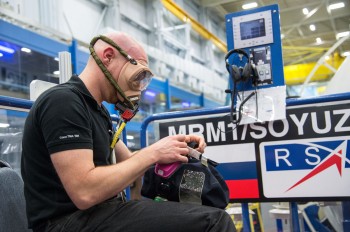How will I find my underwear hidden away in the 1000 lockers on the Space Station?
Spending many years training every day for a space mission you get to know your colleagues very well. Reid Wiseman is one of my Expedition 40 crewmates, an experienced military pilot and the best and most humorous companion you could wish for during spaceflight. I learned from Reid together with frequent laughter that surprisingly many situations exist in which supplying 80 % of the solution is sufficient to succeed.
As simple as that concept may sound, for someone like me who is passionate about science and a former professional perfectionist it feels very unsatisfactory to make do with less than 100 %. To prepare for only 80 % of a volcanic expedition will end in guaranteed failure. Forgetting just one screw can mean the loss of all scientific data on an Antarctic expedition.
The key to success for my previous expeditions was to prepare as perfectly and meticulously as possible, but then switch to MacGyver mode during the expedition itself. Sometimes responsible use of a Swiss Army knife, chewing gum and duct tape is necessary to ensure all equipment runs well.
This strategy is applicable to many tasks on the Space Station such as in emergency responses, which need to be performed perfectly onboard if we are awakened in the middle of the night by a fire alarm for example.
Aside from a few key tasks, the ‘80% view’ of our Expedition is necessary because the International Space Station is the most complex machine ever built by mankind. More than 100 000 people have contributed to this orbital complex so there is no single person who understands the system in detail in its entirety.
Even astronauts, after four and a half years of intensive training for a Space Station mission, only just scratch the surface of knowledge of this complex system. The rest we entrust to a great ground-support team coupled with a measure of flexibility and intuition. We do not even manage to prepare for all everyday operations that await us in Earth orbit. The best we can do, so to speak, is that we are prepared for the fact that everything that happens up there will be different. The challenge is a compelling leap in the dark, as so often when embarking on adventure.
This leap awaits Reid and me tomorrow. On this day, if all goes well, we will experience for the first time, how living space really is. Many of the activities we need to do in zero-gravity on the first day, none of us could ever be trained for: how do you move elegantly through a tangle of cables and fragile devices when no up or down exists? What is the best technique to successfully go to the toilet? How do you get a good night’s sleep in zero gravity? How do you open a bag with 200 loose parts without the contents spreading around the Space Station? How will I shave with no running water? In which of the thousands of lockers on the Space Station will I find my underwear (we have enough underwear to refresh every other day). The simple answer is: I don’t know. Yet.
Prior to launching into space it pays to say goodbye to the comforting “prepared-for-anything-feeling”. But honestly, the 20% of unknown is what I am most looking forward to!
This blog entry was translated from Alexander Gerst’s original text in German.







Discussion: 10 comments
Wishing you and crew well — thanks for sharing these details of preparing for space travel. It is an amazing view into a world not many of us will experience. :)
Viel Glück bei Ihrem Abenteuer !
Sie leben meinen Traum , dafür bewundere ich Sie sehr !
Guten Flug :)!
Freue mich sehr auf den Start und die gesamte Mission! Viel Spaß euch allen und kommt gut nach Hause!
Fixed! thanks…
Good luck! Today is your day my friend. We can only imagine what it must be like out there.. Ahh such a beautiful thought.
Good luck for you, your team and your mission! Should Joda come over, send him right down to earth. We could need him. Have a good flight and return safely back to earth.
Alles liebe und gute für Dich!!
Good luck
toiToiTOI viel spaß und gute heimkehr!
Genau diese menschlichen Gedankengänge haben mich interessiert. Danke für die Teilhabe an Deinen Gefühlen und Gedanken. Jetzt sind Astronauten näher und verständlich für mich. Ich finde es toll mit Dir ein bischen an dem Weltraumabenteuer beteidigt zu sein. Toll.